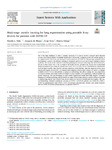Mostrar o rexistro simple do ítem
Multi-Stage Transfer Learning for Lung Segmentation Using Portable X-Ray Devices for Patients With COVID-19
| dc.contributor.author | Vidal, Plácido | |
| dc.contributor.author | Moura, Joaquim de | |
| dc.contributor.author | Novo Buján, Jorge | |
| dc.contributor.author | Ortega Hortas, Marcos | |
| dc.date.accessioned | 2021-04-14T15:05:53Z | |
| dc.date.available | 2021-04-14T15:05:53Z | |
| dc.date.issued | 2021-07 | |
| dc.identifier.citation | Plácido L. Vidal, Joaquim de Moura, Jorge Novo, Marcos Ortega, Multi-stage transfer learning for lung segmentation using portable X-ray devices for patients with COVID-19, Expert Systems with Applications, Volume 173, 2021, 114677, ISSN 0957-4174, https://doi.org/10.1016/j.eswa.2021.114677. (https://www.sciencedirect.com/science/article/pii/S0957417421001184) | es_ES |
| dc.identifier.issn | 0957-4174 | |
| dc.identifier.uri | http://hdl.handle.net/2183/27751 | |
| dc.description.abstract | [Abstract] One of the main challenges in times of sanitary emergency is to quickly develop computer aided diagnosis systems with a limited number of available samples due to the novelty, complexity of the case and the urgency of its implementation. This is the case during the current pandemic of COVID-19. This pathogen primarily infects the respiratory system of the afflicted, resulting in pneumonia and in a severe case of acute respiratory distress syndrome. This results in the formation of different pathological structures in the lungs that can be detected by the use of chest X-rays. Due to the overload of the health services, portable X-ray devices are recommended during the pandemic, preventing the spread of the disease. However, these devices entail different complications (such as capture quality) that, together with the subjectivity of the clinician, make the diagnostic process more difficult and suggest the necessity for computer-aided diagnosis methodologies despite the scarcity of samples available to do so. To solve this problem, we propose a methodology that allows to adapt the knowledge from a well-known domain with a high number of samples to a new domain with a significantly reduced number and greater complexity. We took advantage of a pre-trained segmentation model from brain magnetic resonance imaging of a unrelated pathology and performed two stages of knowledge transfer to obtain a robust system able to segment lung regions from portable X-ray devices despite the scarcity of samples and lesser quality. This way, our methodology obtained a satisfactory accuracy of 0.9761 ± 0.0100 for patients with COVID-19, 0.9801 ± 0.0104 for normal patients and 0.9769 ± 0.0111 for patients with pulmonary diseases with similar characteristics as COVID-19 (such as pneumonia) but not genuine COVID-19. | es_ES |
| dc.description.sponsorship | Xunta de Galicia; ED431C 2020/24 | es_ES |
| dc.description.sponsorship | Xunta de Galicia; IN845D 2020/38 | es_ES |
| dc.description.sponsorship | Xunta de Galicia; ED431G 2019/01 | es_ES |
| dc.description.sponsorship | This research was funded by Instituto de Salud Carlos III, Government of Spain, DTS18/00136 research project; Ministerio de Ciencia e Innovación y Universidades, Government of Spain, RTI2018-095894-B-I00 research project, Ayudas para la formación de profesorado universitario (FPU), grant Ref. FPU18/02271; Ministerio de Ciencia e Innovación, Government of Spain through the research project with reference PID2019-108435RB-I00; Consellería de Cultura, Educación e Universidade, Xunta de Galicia, Grupos de Referencia Competitiva, grant Ref. ED431C 2020/24; Axencia Galega de Innovación (GAIN), Xunta de Galicia, grant Ref. IN845D 2020/38; CITIC, as Research Center accredited by Galician University System, is funded by “Consellería de Cultura, Educación e Universidade from Xunta de Galicia”, supported in an 80% through ERDF Funds, ERDF Operational Programme Galicia 2014-2020, and the remaining 20% by “Secretaría Xeral de Universidades” (Grant ED431G 2019/01). | |
| dc.language.iso | eng | es_ES |
| dc.publisher | Elsevier BV | es_ES |
| dc.relation | info:eu-repo/grantAgreement/MICINN/Plan Estatal de Investigación Científica y Técnica y de Innovación 2017-2020/DTS18%2F00136/ES/Plataforma online para prevención y detección precoz de enfermedad vascular mediante análisis automatizado de información e imagen clínica | |
| dc.relation | info:eu-repo/grantAgreement/MICINN/Plan Estatal de Investigación Científica y Técnica y de Innovación 2017-2020/FPU18%2F02271/ES/ | |
| dc.relation | info:eu-repo/grantAgreement/AEI/Plan Estatal de Investigación Científica y Técnica y de Innovación 2017-2020/RTI2018-095894-B-I00/ES/DESARROLLO DE TECNOLOGIAS INTELIGENTES PARA DIAGNOSTICO DE LA DMAE BASADAS EN EL ANALISIS AUTOMATICO DE NUEVAS MODALIDADES HETEROGENEAS DE ADQUISICION DE IMAGEN OFTALMOLOGICA | |
| dc.relation | info:eu-repo/grantAgreement/AEI/Plan Estatal de Investigación Científica y Técnica y de Innovación 2017-2020/PID2019-108435RB-I00/ES/CUANTIFICACION Y CARACTERIZACION COMPUTACIONAL DE IMAGEN MULTIMODAL OFTALMOLOGICA: ESTUDIOS EN ESCLEROSIS MULTIPLE | |
| dc.relation.uri | https://doi.org/10.1016/j.eswa.2021.114677 | es_ES |
| dc.rights | Atribución-NoComercial-SinDerivadas 4.0 Internacional | es_ES |
| dc.rights.uri | http://creativecommons.org/licenses/by-nc-nd/4.0/ | * |
| dc.subject | CAD system | es_ES |
| dc.subject | Radiography | es_ES |
| dc.subject | X-ray | es_ES |
| dc.subject | Lung segmentation | es_ES |
| dc.subject | COVID-19 | es_ES |
| dc.subject | Transfer learning | es_ES |
| dc.title | Multi-Stage Transfer Learning for Lung Segmentation Using Portable X-Ray Devices for Patients With COVID-19 | es_ES |
| dc.type | info:eu-repo/semantics/article | es_ES |
| dc.rights.access | info:eu-repo/semantics/openAccess | es_ES |
| UDC.journalTitle | Expert Systems with Applications | es_ES |
| UDC.volume | 173 | es_ES |
| UDC.startPage | 114677 | es_ES |
| dc.identifier.doi | 10.1016/j.eswa.2021.114677 |
Ficheiros no ítem
Este ítem aparece na(s) seguinte(s) colección(s)
-
GI-VARPA - Artigos [79]






